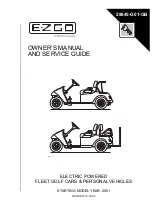
Page M-20
MECHANICAL BRAKES
Repair and Service Manual
Read all of Section B and this section before attempting any procedure. Pay particular attention to all Notes, Cautions and Warnings.
B
Inspect the shoulder bolt for corrosion that could cause
binding. This bolt and both bushings (7) must be
replaced with new ones if corrosion or wear is found.
Brake pedal installation is in the reverse order of disas-
sembly. Tighten the nut (5) to 25 - 29 ft. lbs. (34 - 39 Nm)
torque and use a new cotter pin when installing the com-
pensator assembly. Connect brake light wiring harness,
if equipped.
Adjust the brake pedal free travel. “Adjusting Brake Pedal
Free Travel” on Page M 14
Check for proper brake light operation if equipped.
Parking Brake Catch Bracket Removal and
Installation
Remove the driver side front wheel to gain access to the
brake pedal release mechanism.
To prevent serious injury or death resulting
from the sue of worn parking brake compo-
nents, do not attempt to re-new worn compo-
nents. The catch bracket is a hardened part.
Do not grind or file it as doing so will cause the
part to lose its hardness characteristics. A new
part must be used.
Remove the two bolts (1) and nuts (2) which secure the
catch bracket. Replace the catch bracket with a new
one, replace and tighten the hardware to 85 - 95 in. lbs.
(10 - 11 Nm) torque (Ref. Fig. 28 on Page M-20).
If required, adjust the kick-off cam (3). “Parking Brake
Kick-Off Cam Removal, Replacement and Installation” on Page
M 21
Install wheel. See WHEELS AND TIRES section.
Fig. 28 Catch Bracket and Latch Arm
Parking Brake Pedal, Removal and Installa-
tion
Note the location and orientation of the two torsion
springs (8). Remove the push nut (9) and pin (10) (Ref.
Fig. 27 on Page M-19) and remove the parking brake
pedal. Some models may use two push nuts on the pin.
To prevent serious injury or death resulting
from the use of worn parking brake compo-
nents, do not attempt to re-new worn compo-
n e n t s . T h e p a r k i n g b r a k e a r m l a t c h i s a
hardened part. Do not grind or file it as doing
so will cause the part to lose its hardness char-
acteristics. A new part must be used.
Installation is in the reverse order of disassembly. Use a
new push nut (or push nuts).
If required, adjust the kick-off cam (3). “Parking Brake
Kick-Off Cam Removal, Replacement and Installation” on Page
M 21
Pedal Bumper Adjustment
Loosen the bumper lock nut and adjust the bumper by
rotating it (Ref. Fig. 29 on Page M-20). The brake pedal
must contact the pedal bumper when pedal is released
and the dimension from the top of the pedal arm to the
setscrew heads in the kick-off cam should be approxi-
mately 1/4" - 3/8” (6 - 9.5 mm).
Tighten the lock nut to 12 - 14 ft. lbs. (16 - 19 Nm)
Fig. 29 Pedal Bumper Adjustment
Cam Must Be Against
Latch Arm At This Point
0.0" Gap
(0.0 mm)
1/4" (6 mm) Max Gap At This Point
1
2
3
4
Pedal Latch Arm
Catch Bracket
.03" (.76 mm) Max Gap
After Adjustment Of Cam
Pedal Bumper
Lock
Nut
1/4" - 3/8" (6 - 9.5 mm) Diameter
Drill or Bolt Must Pass
Through Gap































